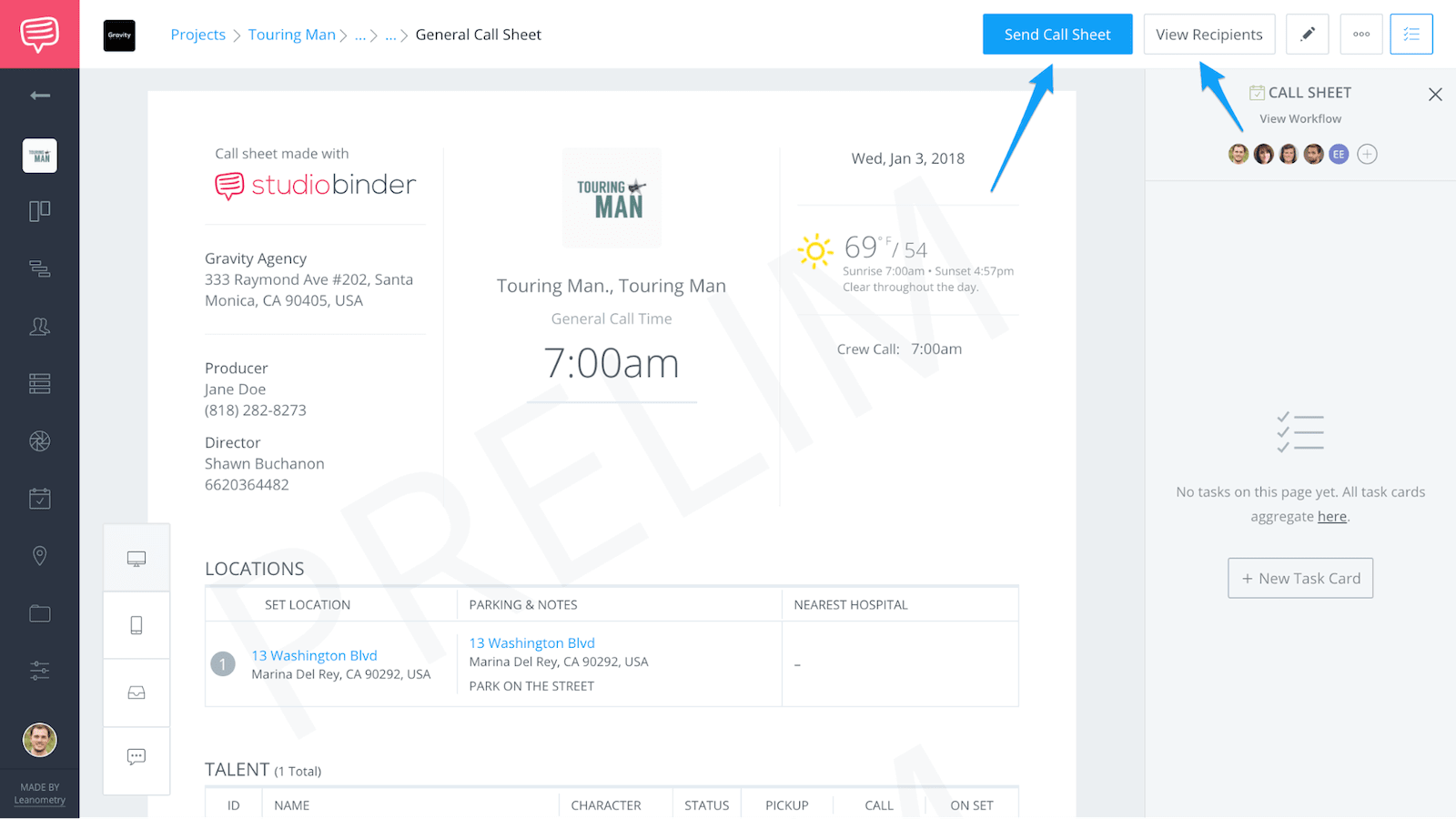Navigating our uber-connected, tech-driven world can be overwhelming for filmmakers. Making a successful short film is exhausting enough. But keeping your crew — and followers — up to date, minute by minute, might feel like one step too many. All of the mediums might overwhelm you, but deep down you know you using them will help your film.
But, you don’t need to be on every single social media platform in order to capitalize. You just need to choose your methods wisely, and set them up for maximum efficiency. In today’s post, I’ll show you what you need to stay connected in order to find your audience.
Digital Communications
1. Set up digital communications early
When learning how to make a short film efficiently, you’ll find that digital communications are essential. Digital communications tools will keep you connected as you navigate development, distribution, and even the film marketing process.
Let’s go over everything you need to communicate with your cast and crew. Then we’ll break out some tools to consider as you approach your film marketing strategy.
Which Digital Communications
2. Keep it to email
It can be very helpful to set up a separate email address for your film. You can use this to set up the accounts related to your film. You can also optimize it to auto-forward to collaborators’ accounts as well.
First, when I set up a new film’s email address, I like to have it auto-forward copies of all incoming emails to my personal email, so I don’t miss anything important.
Sometimes, it can be useful to set up short-term or temporary email addresses for specific phases of production.
For casting and crewing-up, I often create an “auditions@___.com” or “HireMe@____.com” address. This way, when I post casting calls or crew calls to cast and crew websites (craigslist.org, mandy.com, productionbeast.com), I can keep the flood of headshots and resumes from cluttering my main inbox.
If you use Gmail, there are also highly customizable options for filtering your emails as well. This will help you break incoming emails into specific folders for your review.
Keep it to Email
If you’re discussing a production, 21st century etiquette demands that you stick to email.
In the last few years, I’ve had actors, directors, producers and others in the industry communicate with me through Facebook, LinkedIn, Twitter, Instagram, WhatsApp, Google+ and Skype.
For friendly, social interactions these are all appropriate.
But I’ve had situations where people struck a deal with me by a direct message in a social media platform. Then, months later, I couldn’t remember which social media platform was used.
It gets worse.
Some major platforms don’t have a ‘search’ feature in their message history. Unless you remember exactly when and where something was said, you’ll never be able to find the message again.
Email is easily archivable, easily searchable, and ubiquitous. If you must begin a correspondence in another platform, try to move the conversation to email as soon as you can.
Acceptable Alternatives to Email
Of course, I’m no troglodyte! Some new digital communications technology can be extremely useful to your short film.
Text Messages
For high-urgency, short-response communications (such as when you need a quick “yes or no”), text messages are great. If a text demands a longer response, switch to a phone call.
Direct Messages in Social Media Platforms
These should only be used for non-professional, non-urgent conversations. These are not easily archivable or searchable communications, so they are inappropriate for business use.
Group Messaging Services
Applications like WhatsApp offer very convenient group messaging services. You might find it helpful to set up a WhatsApp group for your production team.
If your project is large enough, you may have several overlapping WhatsApp groups for your different departments.
These are useful for quick or urgent communications to a group. No one wants to type out an extended response on their phone, so limit these communications to things like coordinating a meeting time, getting suggestions for a crew position, or communicating that the call time has changed.
CC or BCC Emails
Batch emails are, of course, a useful tool to communicate with multiple people simultaneously.
This is the most common way to send out call sheets, revised script pages, and other production documents to your team.
Remember that some people (especially well-known actors, directors and producers) don’t want their email address circulating to the team, so use the blind carbon copy (BCC) field when you need to prevent their addresses from appearing to the other recipients of your email.
Software for Digital Communications
3. Use film production software
When you produce your short film, you’ll communicate a ton. Prepare to reach out to your various departments every day. Sometimes several times a day.
As important as optimizing your email is, you can get even more aggressive with how you centralize your communications. Watch how StudioBinder does it:
I prefer production softwares like StudioBinder that let me project manage and communicate with my cast and crew simultaneously. That way, I can direct tasks to one place.
If I need to show someone a production task, like a script breakdown or production calendar, I can easily send a link.
And when I’m ready to roll the camera, I can even send out my call sheets -- and track who, amongst my cast and crew, received it.
The lifeline of a production is the crew's ability to communicate effectively. StudioBinder has spoiled me with its ability to streamline this communication, I'm not sure where I'd be without it.
Once we have a strong handle on internal communication, let's wander outside a bit, and see how to draw people to our film.
Related Posts
Film Marketing
4. Do you need a website?
Nope. Next?
Okay, fine, I’ll explain this further.
Most of the online attention you get while promoting a film comes through social media. You’re likely going to have a presence on at least two or three social media platforms.
You’ll likely post production stills, behind-the-scenes photos, and eventually your trailer to these social media pages. While promoting a film, most everything can be conveyed to the world through social media.
Film Marketing w/ Social Media
5. Promote your film on social media
In addition to communicating with your cast, crew, vendors and other companies, you will eventually need to communicate with a broader audience.
Social media shows how to market a movie in the digital age. And if you’re planning a crowdfunding campaign to fund your short film, social film promotion strategies are critical. Learn even more on how to jumpstart your social media advertising here.
Having film marketing campaigns launched on social media may help festivals to choose your film. Usually, short film festivals look for films that will draw an audience, so if you can demonstrate an audience with your social media, you’ll have an easier time convincing festivals to select your film.
Finally, if you’re considering any sort of monetization of your short film, you need to build your social media audience. You can do film marketing with quite a few social media platforms. But find the ones (like Facebook, Twitter and Instagram) that enhance discoverability through linked #hashtags, suggested content, interest groups, etc.
Explore your options and learn how to market a movie beyond your immediate circle of friends and family.
Facebook is the best social media platforms to use while promoting a film. With nearly 1.9 billion users, how couldn’t you?
It’s perfectly common film marketing strategy to use your Facebook page as your primary website.
Through your Facebook page, share photos, videos, production updates and other related content to a dedicated group of followers. Make your posts as shareable as you can to encourage fans to repost your content.
And remember, you won’t get followers on Facebook just by creating a page. You and your team need to share that page in order to draw attention to it, and to share the content that you post to the page.
Our Facebook has been a social media anchor. It’s where we post most of our updates and where most of our fans have found us.
Instagram, by comparison, has considerably fewer users, but it is growing, especially among younger users.
Learning how to market a movie in Instagram is a visual process. So share photos from your shoot, post production stills, and even film festival updates.

How to market a movie on Instagram: use hashtags and get social!
When I started using the platform, I found myself wondering how to get more followers on instagram.
Unlike Facebook, Instagram does not allow users to share each other’s posts. Instead, information is spread by means of an algorithm that selectively suggests content to users.
The more people interact with your Instagram post, the more likely it is to be suggested to other users who have demonstrated similar interests.
Because there are no “pages” in Instagram, the way there are in Facebook, it’s not as useful as a central repository of information about your film.
But Instagram has an active and growing user base.
If you have a solid hold on content, tagging and commenting, you’ll easily discover how to market your movie.
This is an interesting platform to consider. With only 328 million users, it falls far behind even Instagram in terms of social media reach.
But Twitter is still a favorite hangout of celebrities, politicians, journalists and tastemakers. And it has features that give you a chance of actually getting their attention. In particular, Twitter is known for introducing the @ tag to shout at other users.If you’re looking for how to build twitter followers, this is an important tool to use.
An active Twitter celebrity might get tweeted at thousands of times in a day. But if your tweet about your film is compelling or interesting enough, you might get a response. And if you’re super lucky, you might get a retweet.
Twitter is a very limited medium when it comes to what you can express. You’re limited to 140 characters, but you can share photos, videos and links too.
Everything Else
There are other social media platforms out there, and every day, someone introduces a new one into the market.
Each one is different, with different features and a different user base.
If you’re already using one of these other social media platforms, there’s no reason not to explore its use for your film as well.
Just remember: every new social media platform that you add to your arsenal is another website that you need to update when you have news to share. If you’re not careful, the social media game can take over your time.
Related Posts
More on Film Promotion
6. Video hosting services
Technically, video hosting platforms are also social media sites. They are a great place to feature your content and, sometimes, attract a following.
Let’s dive into the best ones to use for film marketing.
YouTube
YouTube has roughly one billion users. Even if you don’t end up posting the short film to your channel, it’s a good place to post behind-the-scenes videos, and eventually, the film’s trailer. Learn how to monetize on YouTube and also, how to make a channel that stands out.
Social media companies are competitive! If you post your trailer to YouTube and then share a link on Facebook, it won’t auto-play in people’s news feed. So it won’t be disseminated as broadly by Facebook’s algorithm.
So make sure to upload your trailer separately to Facebook. You’ll notice that your post is seen by many more of your followers that way, because Facebook ranks internal content more favorably than external links.
Vimeo
For film festival submissions, Vimeo is a common platform choice. The benefit of Vimeo is that you can set a password for each uploaded video.
Many film festival sites will accept a Vimeo link with a password in lieu of a separate video file upload too.
Related Posts
How the Tools Connect
7. Social media integration
One of the ways to make your social media efforts more efficient is to integrate your social media accounts.
If you’re running your short film’s social media accounts on your own, without help, the work can get overwhelming. On my short, “The Pirate Captain Toledano”, I had a publicity intern who managed Instagram and Twitter for me while I focused on Facebook - and even that was a lot of work!
You can set up your social media accounts to syndicate your content from one platform to another.
For example: you can set up YouTube to automatically post to Twitter whenever you upload a video to your account.
And you can setup Twitter to automatically post your tweets to Facebook.
Instagram can also automatically post to Facebook.
It’s possible, in this way, to set up a sort of domino chain of social media sites, wherein you post to one, and the post gets populated to all the others. It’s not a perfect system. Twitter, for example, works best if you post frequent, short, punchy tweets.
Facebook tends to respond better if you post a little less frequently, with more visual content (images and video). Facebook also tends to disseminate internal content more than external content, so your Instagram photo might not spread as far if you syndicate it from Instagram to Facebook, rather than uploading it a second time, directly, to Facebook.
Interconnecting your social media accounts in this way is not an ideal solution, but it is a great way to maintain your social media presence across multiple platforms.
Post Frequently
8. Keep it alive
In screenwriting, when you mention something in a scene just to remind people that it’s there, you’re “keeping it alive."
That’s all social media is about. Post frequently enough, and in enough places, so your friends, family and fans don’t forget that your short film is out there, getting made or getting screened.
Keep it alive!
And when you’re wondering what to post next, always remember: think like an entertainer! Social media is media. It’s an extension of the mass-entertainment that you’re creating.
It’s not hard to know how to make a successful short film while also staying connected. Just think about what people might want to read or see from you - not about what you want to express to them.
You might be frustrated about the challenges of production, or nervous about the prospects of the crowdfunding campaign. That’s not what people want to see.
People want to get a glimpse of movie magic. They want to peek behind the curtain - not so much that cinema loses its magic! Just enough so they can brag about it to their friends.
Effective Communication
9. Wrapping Up
There’s an ocean of digital communications methods out there. You just need to find the ones that match your project and all its film marketing demands.
Keep your communications as inspirational and enthusiastic as you can as you go. And remember to give yourself a break to recharge from time to time.
Now you know how to make a successful short film with a streamlined communications setup. Free yourself to dive into your pre production tasks.
If you’d like to see how my film’s social media stacks up, check out our Facebook and Instagram. And let me know how you handle communications in the comments below!
If you want more on how to use social media to advertise yourself, read the "up next" article. It dives deep into each platform, giving insights into engagement, and how to maximize your benefit.
Related Posts
UP NEXT
Kickstart your social media ads
Now that you're a little more familiar with digital communications, let's dive a little deeper into each one. Social media platforms specifically, will obviously help spread your content, but knowing which ones will be most cost effective, and how to market yourself with each one, will be vital. Read more below.
Project management for video creatives. Tasks, file sharing, calendars and more.
Manage video production timelines, tasks, storyboards, shot lists, breakdowns, call sheets. Made for video creatives, new media and film.



